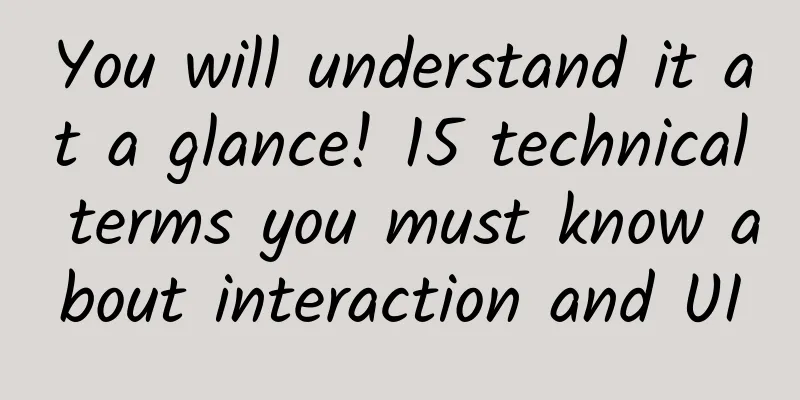You will understand it at a glance! 15 technical terms you must know about interaction and UI

|
We often interact with developers and often hear some technical terms (such as SDK, RT, structured data, etc.). When you hear these, you must have a black question mark face in your mind: What is he talking about???
So today I want to talk about some technical terms that I have personally encountered. The content may not be comprehensive, but I still hope it can bring you some benefits. API and SDK1. API: Application Programming Interface refers to the connection channel between two software/systems to achieve data transmission and processing. For example: The mobile phone is connected to the computer via a USB data cable, and the USB data cable socket is an API interface. Transferring pictures between MacBook and iPhone, the ability to transfer pictures over the air is an API interface Features: A channel to establish a data connection 2. SDK: A software development kit is a virtual installation package that integrates certain functions and can be provided to other companies for external use (the functions inside). For example: The Amap team has generated a map SDK. If some small companies want to directly use the functions of Amap, they can use this map SDK. Features: It can help SDK users save a lot of development costs and human resources, and facilitate/quickly call. For SDK producers, it can expand the existing product ecosystem. Cold Update vs Hot Update1. Hot update: Users will encounter instant updates as soon as they open the application, without having to re-download the entire APP installation package. For example: function updates, game patch downloads Features: It can dynamically release code. It allows developers to release features and fix bugs without releasing a new version. 2. Cold update: Users need to download the complete APP installation package to complete the update method of the entire product. For example: version iteration Features: Developers have to repackage the app every time and submit it to the App Store/Apple for review. After the review is passed, users have to download/update the traffic required for the entire app. SKU and SPU1. SKU: Stock keeping unit: the smallest unit that makes up a product/information, equivalent to a kind of granularity. For example: a layer, a bottle of Xiaoyibao mineral water, a mobile phone color Features: Each SKU is unique and is used to identify other information within the product system. 2. SPU: Standard Product Unit: It can be said to be a collection of the smallest information units. One SPU is equivalent to a grouping of N SKUs. For example: a layer group, a type of Yibao mineral water, a mobile phone message Features: An SPU contains multiple SKUs, and the SPU is unique in the platform system. Structured vs. Unstructured Data1. Structured Data: A data display method with a fixed format, unified structure, and limited length, and can be represented by a two-dimensional relational table. What is a two-dimensional relational table? It is just like a standard Excel table: each row of data represents an entity/a set of information, and the attributes of each row of data are the same (because each column corresponds to a feature). Features: Data display is very standardized 2. Unstructured Data: In contrast to the above, data that is difficult to organize in a unified format/structure and cannot be presented in a two-dimensional relational table. For example: various scattered texts, pictures, video audio, documents, HTML, etc. Features: Information display is relatively scattered Version compatibilityRefers to the coordination or processing of product information and capabilities between new and old versions. It is generally reflected in two aspects: data compatibility and functional compatibility. 1. Data compatibility: Refers to the new and old versions. Are the content, format, and type of data displayed consistent? For example, in the date display, the data format of the old version is May 1, 2020, while the new version is planned to be 2020.05.01. In this case, all date data needs to be unified (compatible) into the format of the new version (decimal point) before the new version goes online. On the registration page, the new version has an additional field for a personal signature. If this field is not returned on the old version, will it cause some problems? 2. Functional compatibility: It refers to the functions newly added in the new version. How to handle them in the old version? In particular, it will make users of the two versions interact with each other. For example, if the new version has voice calls, but the old version does not, how should the old version handle the situation (compatibility) when the new version user initiates a voice call to the old version user? Generally, it will prompt the user that the other party is trying to initiate a voice call with you. The current version does not support it. Please update it quickly. Joint debugging and version closing1. Joint debugging: Refers to the inspection on the data interface. Let's debug the finished interface together to see whether the backend data format is correct, whether the data flow is correct, etc., what parameters will be given, and what content will be returned. 2. Closing: It means that after the test is completed, the app installation package of this stage is ready to be submitted to the App Store for review and release. After the version is closed, you are no longer allowed to submit or modify the code until the next iteration (except for urgent bugs) Yes, I'm talking about cold updates... RT and concurrent users1. RT: System response time: refers to the time it takes for the server to receive, process, and return a request result after the client sends a request. The longer the page takes to load, the longer the RT. Response time includes: request sending time, network transmission time, server processing time 2. Number of concurrent users: The number of online users interacting with the server at the same time. For example, at 9 o'clock in the evening, use WeChat to scan and identify the QR code. The total number of users who are scanning the QR code and in the process of identification is considered as the number of concurrent users, because they are interacting with the server (taking frames for identification) at this time. The success or failure of identification does not count. There are two common misconceptions about the number of concurrent users:
Benchmarks A basis for developers to make technical decisions. Why choose to do this? For example: When should the flash icon in WeChat Scan appear and disappear? This benchmark is to detect the light conditions under the mobile phone camera. The flash icon will only appear when the surrounding light is dim. (Users can find it when they need it, and can't see it when they don't need it) Another example: Why does JD.com have WeChat Pay but not Alipay? Because JD.com and Tencent have a special cooperation, so you know~ Summarize The above are some of the technical terms I personally encountered at Tencent (there is no need to mention the basic ones, such as toast prompts, native pages, etc.). The content is not comprehensive, and it is just my personal opinion. But I still hope it can bring you some benefits and avoid the embarrassing situation of wondering what the word the developer just said means. |
<<: Why can’t mobile phones be multi-tasked like computers?
Recommend
Can eating boiled vegetables help you lose weight? 7 weight loss rumors that you believe are harming your health
Author: Ruan Guangfeng, Deputy Director of Kexin ...
Meituan Takeout’s ranking cannot be improved. How can we check the ranking of Meituan Takeout?
For SEO optimizers, many platforms can be optimiz...
What are the advantages and benefits of renting a large bandwidth server?
What are the advantages and benefits of renting a...
With 470,000 followers on Weibo and 30,000+ followers on each article on his official account, how did NetEase create the internet celebrity Wang Sansan?
Do you still remember the “ Sangcha ” that was al...
Product Operations: 10 Practical Strategies for Attracting New Users!
Nowadays, in an era where traffic is king, the co...
The most powerful brain Wang Yinghao Rubik's Cube advanced course tutorial_The Rubik's Cube is so easy to restore
Wang Yinghao's Rubik's Cube Advanced Cour...
How can new media create year-end promotional hits?
In order to give some inspiration to colleagues w...
Baidu bidding sem data case analysis, how to conduct bidding data analysis?
Friends who do bidding promotion and information ...
What is a virtual world, and can it really be lived in?
Author: Duan Yuechu The virtual world is a fascin...
Continental builds wireless charging terminal for Mercedes-Benz, eliminating clutter in one go
Recently, Continental announced that it has devel...
Examples of ways and methods to attract new members to the community!
What are the common ways to attract new members t...
What does "starting with an egg" mean? This is called native advertising!
When doing information flow advertising , the mos...
How to write good information flow copywriting ideas? 5 creative ideas to help you get inspiration quickly!
Due to the particularity of information flow adve...
The sandstorm is coming again! Be especially alert to these major health hazards!
According to the Central Meteorological Observato...
The test of the Zhuque-3 test rocket was successful. What is the level of my country's reusable rockets?
Produced by: Science Popularization China Produce...









